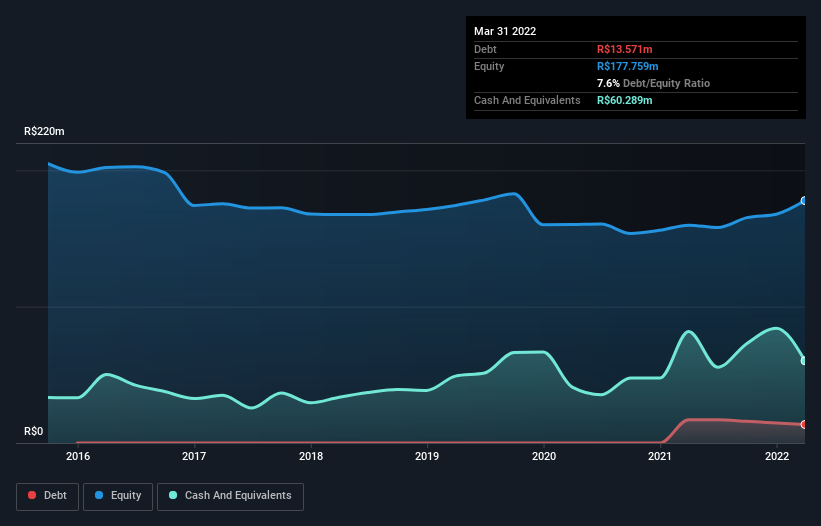- Brazil
- /
- Consumer Durables
- /
- BOVESPA:UCAS3
These 4 Measures Indicate That Unicasa Indústria de Móveis (BVMF:UCAS3) Is Using Debt Safely
Some say volatility, rather than debt, is the best way to think about risk as an investor, but Warren Buffett famously said that 'Volatility is far from synonymous with risk.' So it seems the smart money knows that debt - which is usually involved in bankruptcies - is a very important factor, when you assess how risky a company is. Importantly, Unicasa Indústria de Móveis S.A. (BVMF:UCAS3) does carry debt. But the more important question is: how much risk is that debt creating?
Why Does Debt Bring Risk?
Debt is a tool to help businesses grow, but if a business is incapable of paying off its lenders, then it exists at their mercy. Part and parcel of capitalism is the process of 'creative destruction' where failed businesses are mercilessly liquidated by their bankers. While that is not too common, we often do see indebted companies permanently diluting shareholders because lenders force them to raise capital at a distressed price. Of course, the upside of debt is that it often represents cheap capital, especially when it replaces dilution in a company with the ability to reinvest at high rates of return. When we think about a company's use of debt, we first look at cash and debt together.
View our latest analysis for Unicasa Indústria de Móveis
How Much Debt Does Unicasa Indústria de Móveis Carry?
You can click the graphic below for the historical numbers, but it shows that Unicasa Indústria de Móveis had R$13.6m of debt in March 2022, down from R$17.0m, one year before. But it also has R$60.3m in cash to offset that, meaning it has R$46.7m net cash.

A Look At Unicasa Indústria de Móveis' Liabilities
We can see from the most recent balance sheet that Unicasa Indústria de Móveis had liabilities of R$117.9m falling due within a year, and liabilities of R$18.1m due beyond that. On the other hand, it had cash of R$60.3m and R$41.6m worth of receivables due within a year. So it has liabilities totalling R$34.2m more than its cash and near-term receivables, combined.
While this might seem like a lot, it is not so bad since Unicasa Indústria de Móveis has a market capitalization of R$165.2m, and so it could probably strengthen its balance sheet by raising capital if it needed to. But we definitely want to keep our eyes open to indications that its debt is bringing too much risk. Despite its noteworthy liabilities, Unicasa Indústria de Móveis boasts net cash, so it's fair to say it does not have a heavy debt load!
On top of that, Unicasa Indústria de Móveis grew its EBIT by 55% over the last twelve months, and that growth will make it easier to handle its debt. The balance sheet is clearly the area to focus on when you are analysing debt. But you can't view debt in total isolation; since Unicasa Indústria de Móveis will need earnings to service that debt. So when considering debt, it's definitely worth looking at the earnings trend. Click here for an interactive snapshot.
But our final consideration is also important, because a company cannot pay debt with paper profits; it needs cold hard cash. While Unicasa Indústria de Móveis has net cash on its balance sheet, it's still worth taking a look at its ability to convert earnings before interest and tax (EBIT) to free cash flow, to help us understand how quickly it is building (or eroding) that cash balance. Over the most recent three years, Unicasa Indústria de Móveis recorded free cash flow worth 72% of its EBIT, which is around normal, given free cash flow excludes interest and tax. This cold hard cash means it can reduce its debt when it wants to.
Summing up
Although Unicasa Indústria de Móveis's balance sheet isn't particularly strong, due to the total liabilities, it is clearly positive to see that it has net cash of R$46.7m. And it impressed us with its EBIT growth of 55% over the last year. So is Unicasa Indústria de Móveis's debt a risk? It doesn't seem so to us. The balance sheet is clearly the area to focus on when you are analysing debt. However, not all investment risk resides within the balance sheet - far from it. These risks can be hard to spot. Every company has them, and we've spotted 4 warning signs for Unicasa Indústria de Móveis (of which 1 makes us a bit uncomfortable!) you should know about.
At the end of the day, it's often better to focus on companies that are free from net debt. You can access our special list of such companies (all with a track record of profit growth). It's free.
New: AI Stock Screener & Alerts
Our new AI Stock Screener scans the market every day to uncover opportunities.
• Dividend Powerhouses (3%+ Yield)
• Undervalued Small Caps with Insider Buying
• High growth Tech and AI Companies
Or build your own from over 50 metrics.
Have feedback on this article? Concerned about the content? Get in touch with us directly. Alternatively, email editorial-team (at) simplywallst.com.
This article by Simply Wall St is general in nature. We provide commentary based on historical data and analyst forecasts only using an unbiased methodology and our articles are not intended to be financial advice. It does not constitute a recommendation to buy or sell any stock, and does not take account of your objectives, or your financial situation. We aim to bring you long-term focused analysis driven by fundamental data. Note that our analysis may not factor in the latest price-sensitive company announcements or qualitative material. Simply Wall St has no position in any stocks mentioned.
About BOVESPA:UCAS3
Unicasa Indústria de Móveis
Unicasa Indústria de Móveis S.A. manufacture, sell, import, and export furniture in Brazil.
Second-rate dividend payer with low risk.
Market Insights
Community Narratives



